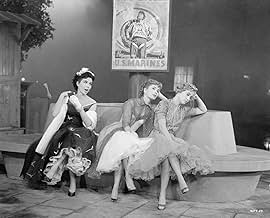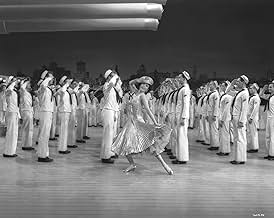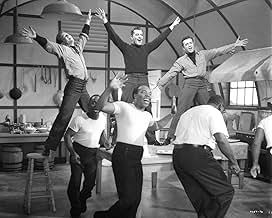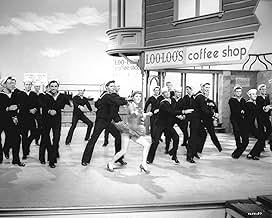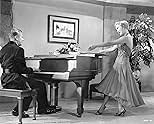IMDb रेटिंग
6.5/10
1 हज़ार
आपकी रेटिंग
अपनी भाषा में प्लॉट जोड़ेंThree sailors come ashore in San Francisco and take the city by storm, but can they win the hearts of three women by song?Three sailors come ashore in San Francisco and take the city by storm, but can they win the hearts of three women by song?Three sailors come ashore in San Francisco and take the city by storm, but can they win the hearts of three women by song?
- पुरस्कार
- कुल 1 जीत
The Jubalaires
- Themselves
- (as Jubalaires)
Jerry Antes
- Dancer
- (बिना क्रेडिट के)
Jimmy Brooks
- Dancer
- (बिना क्रेडिट के)
Buddy Bryan
- Dancer
- (बिना क्रेडिट के)
फ़ीचर्ड समीक्षाएं
Though this film has plenty of talent in the lead roles, it has an unimpressive story and the songs are not inspiring as a whole. However, the film grew on me as it progressed. By its end, I found myself actually enjoying it.
The female leads are very strong. Consider Jane Powell, Debbie Reynolds and Ann Miller. But the three leading men do not generate as much on-screen magic, leaving the production imbalanced and the love stories uninspiring.
"On the Town" (1949)---in contrast---is a much stronger film, that possesses energy throughout.
The female leads are very strong. Consider Jane Powell, Debbie Reynolds and Ann Miller. But the three leading men do not generate as much on-screen magic, leaving the production imbalanced and the love stories uninspiring.
"On the Town" (1949)---in contrast---is a much stronger film, that possesses energy throughout.
Having watched this recently on TCM and not being familiar with the film beforehand, I was drawn in by the quick pace and competent acting, not to mention the pretty leading gals Reynolds and Miller.. quite satisfying eye candy. But then.. came the "fun-house" musical number towards the end and that just blew me away: I mean 'psychedelic' before the word existed, perhaps surreal in contemporaneous nomenclature. That segment stood out as the perhaps the very best part, it was a thrill to watch the choreographed-to-the-second, wild and unpredictable ride of a dance routine! That film was a lot of fun to watch on a lonely night home. So reviewer whoever-you-are that hates every movie unless it has something blowing up every twelve seconds, perhaps stick to writing up Popeye cartoons where the plots and characters aren't too complex for your limited imagination. I recommend movie this as essential viewing for every musical fan.. it won't disappoint.
This may have been made in the dying days of MGM musicals. No Sinatra. No Kelly. But it has some spectacular classic songs by Vincent Youmans. Plus 2 of the finest voices of all time singing together:
Tony Martin & Vic Damone. AND superior musical arrangements & Russ Tamblyn dancing.
Never mind the negative reviews elsewhere. They do not make them like this any more. For sure. So enjoy it! Great musical!!
Tony Martin & Vic Damone. AND superior musical arrangements & Russ Tamblyn dancing.
Never mind the negative reviews elsewhere. They do not make them like this any more. For sure. So enjoy it! Great musical!!
HIT THE DECK is a 1955 cinema scope mop up of MGM stars and talent whose contracts would have been soon to expire. A bit like a aircraft carrier version of DEEP IN MY HEART it hangs together a roster of singing and dancing talent but this time with ultimately fairly just-OK songs and energetic dance numbers. Still, even at its most bland it is still unable to be made in Hollywood today. The women are the most interesting talent on offer and whoever said Tony Martin had an audience apart from Mummas in delicatessens was truly misled. He is the most annoying part of this B grade musical with A grade MGM production values. Like he did with the Marx Bros films in the 30s. Kelly was making ITS ALWAYS FAIR WEATHER another 'sailors on leave' 1955 cinema scope MGM musical at the same time and that film with its Comden Green script and songs is light years ahead in sophistication and quality. Still HIT THE DECK has a two of very entertaining 'big' dance numbers, in particular the "finale" and the "Bayou" sizzler with its very erotic and blatant imagery and choreography. It is so out of place in this 'suburban' film as it is sooo good. The color is also very good for Eastman since MGM saw the error of their ways and stopped using horrible Ansco color which visually marred several big films in 53 and 54. This must have been as safe a bet in which MGM could expect to play out as many stars as possible in yet one more sailor musical. Russ Tamblyn and Debbie Reynolds are always cute in this era though.
Some films aren't simply movies-they're time capsules. Hit the Deck (1955), Roy Rowland's lavish adaptation of the 1927 stage musical, shines as a heartfelt homage to the mid-century American musical. It dances through moments of joy, romance, and camaraderie with a sense of purpose: to entertain. While it may lack the narrative finesse of MGM's greatest musicals, its exuberance, star-studded cast, and showstopping numbers make it a delightful-if imperfect-experience.
Hit the Deck carries a legacy that spans decades. Originally a stage musical in 1927 and based on Hubert Osborne's play Shore Leave (1922), it was a roaring success in its day. The story-about love and mischief during sailors' shore leave-captured the carefree spirit of the Roaring Twenties. The stage version's music, penned by Vincent Youmans, became an instant hit, with songs like "Sometimes I'm Happy" and "Hallelujah!" embedding themselves in popular culture.
The transition to screen began with RKO's 1930 adaptation, but MGM's 1955 version added new gloss. By then, the studio was desperate to revive a flagging genre, competing with the rise of television. Roy Rowland's film introduced CinemaScope technology and dazzling Technicolor to reinvigorate the classic material. The film wasn't just a rehash; it aimed to give a modern spin to its predecessors, resulting in a product both nostalgic and forward-looking.
The film's casting is an ode to MGM's star system, featuring legends Jane Powell, Debbie Reynolds, Ann Miller, and Tony Martin. While Powell and Reynolds brought youthful charm and vocal prowess, Miller's fiery energy and tap-dancing skills stole every scene she was in. Russ Tamblyn, despite not being a trained dancer, demonstrated an effortless athleticism that added an endearing spontaneity to his role as the impish Danny.
Behind the camera, choreographer Hermes Pan-Fred Astaire's long-time collaborator-imbued the musical numbers with a sense of joy and improvisation. The battleship finale reprise of "Hallelujah!" is a crowning achievement, blending spectacle with intimacy as sailors and civilians unite in a rousing, free-spirited celebration. The funhouse sequence with Reynolds and Tamblyn is another standout, echoing Fred Astaire's playful "Stiff Upper Lip" number from A Damsel in Distress.
The plot, while serviceable, was less memorable than the musical numbers. It follows three sailors on shore leave, their romantic entanglements, and the inevitable hijinks that ensue. The narrative feels like a patchwork quilt-disjointed but colorful-allowing the cast's charm and musical set pieces to take precedence over storytelling.
At its release, Hit the Deck struggled to recoup its substantial production costs. With box office losses of $454,000, it marked a decline in the MGM musical's golden era. Critics were lukewarm, praising the performances but pointing out the contrived plot and uneven pacing. Audiences, however, found joy in its dazzling musical numbers and the chemistry of its ensemble cast.
Over time, the film has garnered a loyal following among musical enthusiasts. Its inclusion in That's Entertainment! (1974) brought renewed attention, particularly to the finale sequence of "Hallelujah!" This number, celebrated for its improvisational charm, has been hailed as one of MGM's most freewheeling and joyous creations. Russ Tamblyn's athletic performance and Ann Miller's sizzling solo continue to be highlights for fans of classic Hollywood choreography.
The film also represents a bittersweet farewell for many of its stars. Jane Powell, Tony Martin, and J. Carrol Naish made their final MGM appearances here, while Debbie Reynolds and Russ Tamblyn stayed on for a few more years. Their performances encapsulate an era of cinematic magic that, while fading, left a lasting impression.
Hit the Deck may not be MGM's most polished gem, but it shines with the unrestrained joy and heartfelt performances that defined a bygone era. It reminds us of the sheer pleasure of escapist cinema-a kind that only classic Hollywood could deliver. If you're in the mood for vibrant colors, timeless melodies, and a touch of nostalgia, this musical is well worth revisiting.
Hit the Deck carries a legacy that spans decades. Originally a stage musical in 1927 and based on Hubert Osborne's play Shore Leave (1922), it was a roaring success in its day. The story-about love and mischief during sailors' shore leave-captured the carefree spirit of the Roaring Twenties. The stage version's music, penned by Vincent Youmans, became an instant hit, with songs like "Sometimes I'm Happy" and "Hallelujah!" embedding themselves in popular culture.
The transition to screen began with RKO's 1930 adaptation, but MGM's 1955 version added new gloss. By then, the studio was desperate to revive a flagging genre, competing with the rise of television. Roy Rowland's film introduced CinemaScope technology and dazzling Technicolor to reinvigorate the classic material. The film wasn't just a rehash; it aimed to give a modern spin to its predecessors, resulting in a product both nostalgic and forward-looking.
The film's casting is an ode to MGM's star system, featuring legends Jane Powell, Debbie Reynolds, Ann Miller, and Tony Martin. While Powell and Reynolds brought youthful charm and vocal prowess, Miller's fiery energy and tap-dancing skills stole every scene she was in. Russ Tamblyn, despite not being a trained dancer, demonstrated an effortless athleticism that added an endearing spontaneity to his role as the impish Danny.
Behind the camera, choreographer Hermes Pan-Fred Astaire's long-time collaborator-imbued the musical numbers with a sense of joy and improvisation. The battleship finale reprise of "Hallelujah!" is a crowning achievement, blending spectacle with intimacy as sailors and civilians unite in a rousing, free-spirited celebration. The funhouse sequence with Reynolds and Tamblyn is another standout, echoing Fred Astaire's playful "Stiff Upper Lip" number from A Damsel in Distress.
The plot, while serviceable, was less memorable than the musical numbers. It follows three sailors on shore leave, their romantic entanglements, and the inevitable hijinks that ensue. The narrative feels like a patchwork quilt-disjointed but colorful-allowing the cast's charm and musical set pieces to take precedence over storytelling.
At its release, Hit the Deck struggled to recoup its substantial production costs. With box office losses of $454,000, it marked a decline in the MGM musical's golden era. Critics were lukewarm, praising the performances but pointing out the contrived plot and uneven pacing. Audiences, however, found joy in its dazzling musical numbers and the chemistry of its ensemble cast.
Over time, the film has garnered a loyal following among musical enthusiasts. Its inclusion in That's Entertainment! (1974) brought renewed attention, particularly to the finale sequence of "Hallelujah!" This number, celebrated for its improvisational charm, has been hailed as one of MGM's most freewheeling and joyous creations. Russ Tamblyn's athletic performance and Ann Miller's sizzling solo continue to be highlights for fans of classic Hollywood choreography.
The film also represents a bittersweet farewell for many of its stars. Jane Powell, Tony Martin, and J. Carrol Naish made their final MGM appearances here, while Debbie Reynolds and Russ Tamblyn stayed on for a few more years. Their performances encapsulate an era of cinematic magic that, while fading, left a lasting impression.
Hit the Deck may not be MGM's most polished gem, but it shines with the unrestrained joy and heartfelt performances that defined a bygone era. It reminds us of the sheer pleasure of escapist cinema-a kind that only classic Hollywood could deliver. If you're in the mood for vibrant colors, timeless melodies, and a touch of nostalgia, this musical is well worth revisiting.
क्या आपको पता है
- ट्रिवियाBased on his athletic dancing in films such as this one and Tom Thumb (1958), most audiences assume that Russ Tamblyn was a trained dancer. In fact, the actor had no history of dance training. He was a skilled tumbler, and that was originally slated to be his singular contribution to Seven Brides for Seven Brothers (1954), but his natural movement ability was so accomplished that he was incorporated more and more into the dance sequences. This would ultimately culminate in his being cast as Riff in West Side Story (1961), one of the most dance-heavy musicals in Broadway history.
- भाव
Chief Boatswain's Mate William F. Clark: Ginger, baby, I worship the ground you walk on!
Ginger: Now he's talking real estate!
- क्रेज़ी क्रेडिटAnd Introducing Kay Armen
- कनेक्शनFeatured in 1955 Motion Picture Theatre Celebration (1955)
- साउंडट्रैकOverture (Join the Navy)
(1927) (uncredited)
Music by Vincent Youmans
Lyrics by Leo Robin and Clifford Grey
Performed by the MGM Studio Orchestra and Chorus Conducted by George Stoll
टॉप पसंद
रेटिंग देने के लिए साइन-इन करें और वैयक्तिकृत सुझावों के लिए वॉचलिस्ट करें
- How long is Hit the Deck?Alexa द्वारा संचालित
विवरण
- रिलीज़ की तारीख़
- कंट्री ऑफ़ ओरिजिन
- भाषा
- इस रूप में भी जाना जाता है
- ¡Qué pícaras mujeres!
- फ़िल्माने की जगहें
- उत्पादन कंपनी
- IMDbPro पर और कंपनी क्रेडिट देखें
बॉक्स ऑफ़िस
- बजट
- $23,00,000(अनुमानित)
- चलने की अवधि1 घंटा 52 मिनट
- ध्वनि मिश्रण
- 4-Track Stereo(original master sound track)
- पक्ष अनुपात
- 2.55 : 1
इस पेज में योगदान दें
किसी बदलाव का सुझाव दें या अनुपलब्ध कॉन्टेंट जोड़ें





